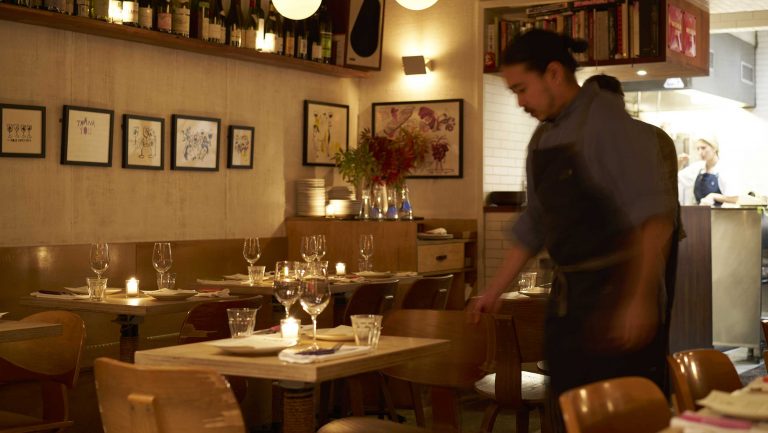Many considerations factor into building a beverage program, including the concept for the restaurant or bar, the budget, and the venue’s location. One of the largest considerations is entirely practical: physical storage space. SevenFifty Daily asked beverage directors working with wine, beer, and spirits how they manage small storage spaces in order to maximize their beverage selections.
1. Create a plan early on.
Beverage storage should be one of the first considerations for any restaurant with a focus on wine, beer, or spirits. “Come up with a plan to maximize storage,” says Ryan Arnold, the divisional wine director for Lettuce Entertain You in Chicago, “as this important factor should dictate the size of your program.” This may require multiple storage locations throughout the front and back of house, so be sure to clearly outline a plan or map of where everything is located. “It’s imperative that all employees understand the flow of wine,” Arnold notes, “and where to pull from during service.”
2. Think of it as an opportunity to better curate your offerings.
“Try not to think of small storage spaces as limiting,” says Shelley Lindgren, the partner and wine director of SPQR and A16 in San Francisco, “but as an opportunity to be careful about selections—and keeping them fresh.” Regardless of whether the beverage focus is in the wine, beer, or spirits realm, a beverage director working with a small storage space should create a direction or theme for his or her program, which will serve to harness the number of selections. For instance, Lindgren used the concept of Roman roads to design the list at SPQR, which serves to categorize and condense the restaurant’s program. Matt Piacentini, the owner and general manager of The Up & Up in Manhattan, notes that it’s also important to match the scope and style of the menu to what the bar can physically accommodate. “There are lots of things I’d like to do at my bar,” he says, “but I know we simply don’t have the setup or resources to do it well.”

Don’t miss the latest drinks industry news and insights. Sign up for our award-winning newsletters and get insider intel, resources, and trends delivered to your inbox every week.
3. Take a “less is more” approach.
Since only so many bottles can be stored when space is limited, scaling down is one solution to help the beverage director avoid the necessity of ordering several times each week. “If you are space-challenged, go with a smaller menu,” Piacentini says. “You can take bigger case drops of fewer items, allowing you to take advantage of discounts. It also makes storage easier because you don’t have too many different items that need homes.”
4. Don’t underestimate the power of shelving.
“Stick shelves everywhere you can,” Piacentini says. “The more that can be built in, the better.” While it’s important to be mindful of storage temperature for wine, beer, and any cocktail component that is less than 20% ABV, Metro shelving—a brand that has become an industry standard for wire shelving—can work well for back-of-house spaces, while decorative, custom-built shelves add extra storage in front-of-house spaces. “We store the majority of our backup well wine and spirits on decorative shelving above the bar,” says Annie Blake, co-owner of Death or Glory in Delray Beach, Florida. “This allows for wine and spirits to be within easy reach for the bartenders and barbacks, and a well-stocked bar provides for a nice aesthetic.”

5. Seek out creative storage solutions.
Look beyond the obvious storage spaces to find unique opportunities for efficiency. Lindgren stores wine in some of A16’s banquettes, which turned out to have an unexpected benefit. “The strange thing is that the cement beneath the bottles remains at a good temperature for wines,” she says, “almost like being in a cave.”
6. Consider forgoing draft beer.
It may seem controversial, but Blake found that removing kegs, draft lines, and taps freed up storage space without sacrificing the quality of Death or Glory’s beer selection. “Opening up the space where the kegs were allowed us to have a much larger selection of craft beer and wine,” she says. “Bottles and cans are easily stacked and give us the ability to have a wider variety and less waste.” Because draft beer often results in variance, given the waste incurred when running lines and pouring drafts, there can be a financial benefit to forgoing kegs.
7. Don’t let a lack of cellar space hold you back.
While it’s always optimal to store wines at temperature in a cellar, there are options for restaurant and bars without cellar space. One solution is investing in temperature-controlled storage options. “We’ve had great experience with EuroCave Pure L at the last two restaurants we’ve opened,” Arnold says, referencing a 180-bottle, energy-efficient wine fridge. “It’s super quiet and fairly easy to arrange the slabs [shelves] for custom wine storage.” If temperature-controlled, front-of-house beverage storage is limited or could become congested by staff staff members during service, Lindgren suggests setting up ice buckets for by-the-glass wines.

8. Keep beverage stock moving.
If storage space is running particularly low, that’s a good opportunity to move long-sitting bottles. “When we have a spirit that sits for a little too long, we get creative,” Blake says. The team at Death or Glory will create a daily or weekly punch special to move extra inventory, when needed. It may also be worthwhile to put a slow-moving wine on a pairing menu or as a by-the-glass special.

Dispatch
Sign up for our award-winning newsletter
Don’t miss the latest drinks industry news and insights—delivered to your inbox every week.
Courtney Schiessl Magrini is the editor-in-chief for SevenFifty Daily and the Beverage Media Group publications. Based in Brooklyn, she has held sommelier positions at some of New York’s top restaurants, including Marta, Dirty French, and Terroir, and her work has appeared in Wine Enthusiast, GuildSomm, Forbes.com, VinePair, EatingWell Magazine, and more. She holds the WSET Diploma in Wines. Follow her on Instagram at @takeittocourt.








